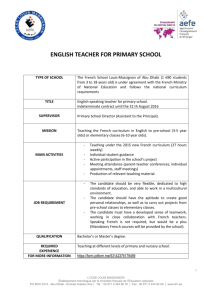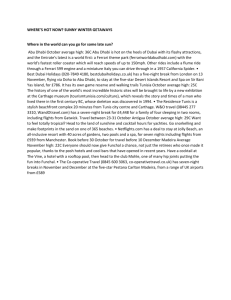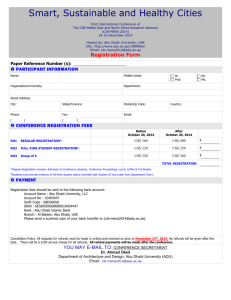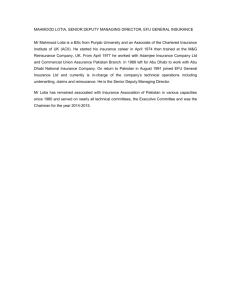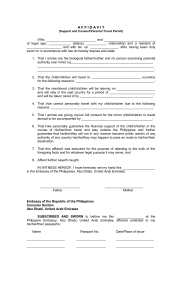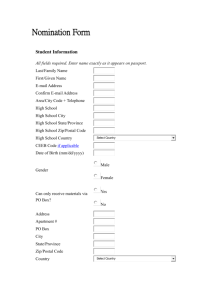GMP: Risk analysis in pharmaceutical production and quality
advertisement
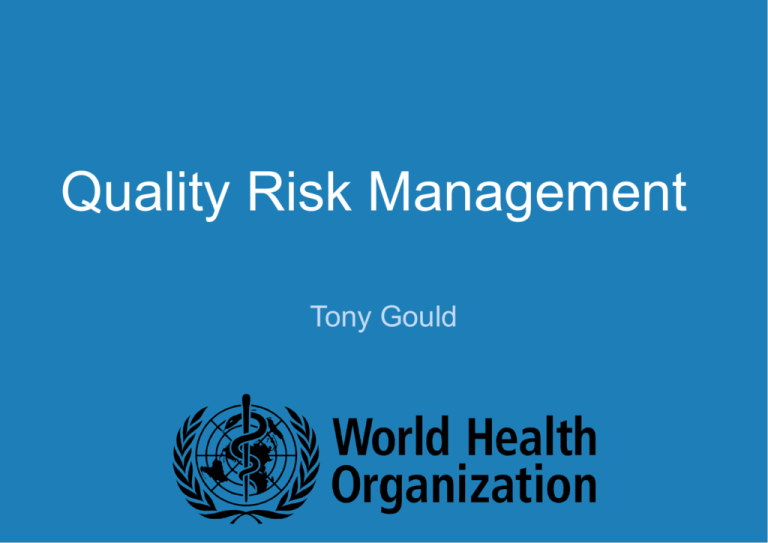
Quality Risk Management Tony Gould Introduction 2 | Risk management is not new – we do it informally all the time Military Standard 1629 dated 1974 regarding formal risk management Risk management has been used in the medical device, telecommunications, aerospace and car industries for many years PQ Workshop, Abu Dhabi | October 2010 Introduction Risk management has also been part of the pharma industry for many years: – GMP requirements are designed to address risk. For example, the specific GMP requirements for sterile products are designed to mitigate the risk of sterility failure – In some cases, GMP specifies a risk based approach. For example, "a risk assessment approach should be used to determine the scope and extent of validation required" (WHO Annex 4, 5.2.10) – Specifications in pharmacopoeial monographs include tests for known potential contaminants 3 | PQ Workshop, Abu Dhabi | October 2010 Introduction 4 | Greater use of risk management tools in the future We must accept this and prepare From a GMP point of view, we are only concerned with risks associated with quality, safety and efficacy – quality risk management Organisations use risk approaches in other areas, e.g. to ensure resources are utilised in the most effective way. Also applicable to inspectorates PQ Workshop, Abu Dhabi | October 2010 GMP requirement A system for quality risk management should be included in the quality assurance system Quality risk management is a systematic process for the assessment, control, communication and review of risks to the quality of the medicinal product. It can be applied both proactively and retrospectively. The quality risk management system should ensure that: – the evaluation of the risk to quality is based on scientific knowledge, experience with the process and ultimately links to the protection of the patient; and – the level of effort, formality and documentation of the quality isk management process is commensurate with the level of risk. 1.2 – 1.5 5 | PQ Workshop, Abu Dhabi | October 2010 QRM - the dangers There is a desired outcome and risk management is used to justify it Invalid assumptions – suit the desired outcome Cost reduction (increased profits) is often the real reason that many risk assessments are done – Cost reduction may be a secondary outcome Variable tolerance of risk 6 | PQ Workshop, Abu Dhabi | October 2010 QRM – from an inspectors point of view 7 | Be prepared so that the process is understood Have sufficient knowledge to understand what has been done and challenge assumptions, omissions etc Be clear about when QRM is not appropriate Be flexible and accept the outcome of a scientifically sound QRM exercise If done properly there should be increased assurance of quality (and possibly cost savings) PQ Workshop, Abu Dhabi | October 2010 What is QRM 8 | "Quality Risk Management is a systematic process for the assessment, control, communication and review of risks to the quality of the medicinal product across the product lifecycle." (ICH Q9) PQ Workshop, Abu Dhabi | October 2010 Typical QRM process Initiate Quality Risk Management Process Risk Assessment Risk Identification Risk Analysis Risk Evaluation Risk Communication Risk Control Risk Reduction Risk Acceptance Output / Result of the Quality Risk Management Process Risk Review Review Events 9 | PQ Workshop, Abu Dhabi | October 2010 Risk Management tools unacceptable What might go wrong or has gone wrong? What is likelihood or probability? What are the consequences (severity)? What is the level of risk? Any mitigating factors? Risk assessment 10 | "A systematic process of organizing information to support a risk decision to be made within a risk management process. It consists of the identification of hazards and the analysis and evaluation of risks associated with exposure to those hazards." (ICH Q9) PQ Workshop, Abu Dhabi | October 2010 Risk assessment terms Risk identification – Use of information to identify hazards or potential risks – Historical data, theoretical analysis, informed opinions Risk analysis – – – – 11 | Estimation of risk associated with identified hazards Qualitative or quantitative Links probability and severity In some tools, includes detectability PQ Workshop, Abu Dhabi | October 2010 Risk analysis - probability A simple qualitative tool: P – Probability of Occurrence High Medium Low Remote 12 | PQ Workshop, Abu Dhabi | October 2010 Likely to occur May occur Unlikely to occur Very unlikely to occur Risk analysis - severity A simple qualitative tool: S – severity level if event occurs Critical Moderate Minor 13 | Serious GMP non-compliance Patient injury possible Significant GMP non-compliance Impact on patient possible Minor GMP non-compliance No patient impact PQ Workshop, Abu Dhabi | October 2010 Risk assessment terms Risk evaluation – – – – Compares identified and analysed risk against criteria Considers probability, severity and detectability Output can be qualitative (high, medium or low) Output can be quantitative (probability x severity x detectability) – Quantitative provides a relative ranking – prioritises risk 14 | PQ Workshop, Abu Dhabi | October 2010 Risk evaluation A simple risk table with risk acceptability criteria: Risk = P x S Severity Probability Moderate Critical Unacceptable risk Intolerable risk Intolerable risk Medium Acceptable risk Unacceptable risk Intolerable risk Low Acceptable risk Acceptable risk Unacceptable risk Remote Acceptable risk Acceptable risk Acceptable risk High 15 | Minor PQ Workshop, Abu Dhabi | October 2010 Risk evaluation Modify evaluated risk according to existing detection controls Detectability: – High – the control is likely to detect the negative event or its effects – Medium – the control may detect the negative event or its effects – Low – the control is not likely to detect the negative event or its effects – Zero – no detection control in place 16 | PQ Workshop, Abu Dhabi | October 2010 Risk evaluation Risk definitions: Intolerable – work to eliminate the negative event or introduce detection controls is required as a priority Unacceptable – work to reduce the risk or control the risk to an acceptable level is required Acceptable – the risk is acceptable and no risk reduction or detection controls are required 17 | PQ Workshop, Abu Dhabi | October 2010 Risk control "Actions implementing risk management decisions" (ICH Q9) – Includes risk reduction (if applicable) and risk acceptance 18 | PQ Workshop, Abu Dhabi | October 2010 Risk control terms Risk reduction – Actions taken to lessen the probability of occurrence of harm and the severity of that harm – Typically CAPA and change control Risk acceptance – The decision to accept risk – If risk reduction action taken, follows re-analysis and evaluation 19 | PQ Workshop, Abu Dhabi | October 2010 Risk Review "Review or monitoring of output/results of the risk management process considering (if appropriate) new knowledge and experience about the risk." (ICH Q9) – Ensures nothing has changed to affect the QRM assumptions, output and conclusions – Consider during product review 20 | PQ Workshop, Abu Dhabi | October 2010 QRM tools – some of them! Basic risk management facilitation methods (flowcharts, check sheets etc.); Failure Mode Effects Analysis (FMEA); Failure Mode, Effects and Criticality Analysis (FMECA); Fault Tree Analysis (FTA); Hazard Analysis and Critical Control Points (HACCP); Hazard Operability Analysis (HAZOP); Preliminary Hazard Analysis (PHA); Risk ranking and filtering; Supporting statistical tools. 21 | PQ Workshop, Abu Dhabi | October 2010 Potential applications 22 | Quality Management (e.g. self-inspection, training, complaints, deviations, change control) Development (ICH Q8) Facilities, Equipment and Utilities (e.g. design, qualification, hygiene, calibration, computers) Materials Management (e.g. supplier assessment, storage) Production (e.g. validation, in-process sampling and testing) Laboratory Control and Stability Studies (e.g. OOS, retest periods, validation) Packaging and Labelling (e.g. package design, label control) PQ Workshop, Abu Dhabi | October 2010
